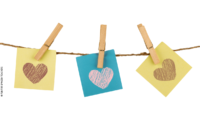What do I include in the box?
I include flash cards related to what we are learning in class, stuffed animals and other kind of props I can find in it. Sometimes I just include one thing and give them clues for them to guess what could be inside the box.
I always sing this song when I use the magic box:
¡En la caja mágica encontrarás
Una sorpresa que te encantará! (3 times)
Click here to sample/buy song on Amazon
We also chant:
¿Qué hay, qué hay en la caja mágica?
¿Qué hay, qué hay en la caja mágica?
After singing the song, I will also give them clues. I usually put something related to what we have been doing in class in the box. For example,
1. Hay un animal.
2. Hay un animal verde.
3. Hay un animal verde que tiene ojos grandes.
4. Hay un animal verde que tiene ojos grandes y salta.
Then I count to three and start taking guesses. Once I reveal the the secret, I ask questions about it again and use a lot of gestures. These are some of the questions I would ask:
1. ¿Es un animal o una persona? ¿Qué es? ¿Qué animal es?
2. ¿De qué color es? ¿Es verde o amarillo?
3. ¿Tiene ojos grandes o pequeños?
4. ¿Nada o salta?
5. ¿Te gustan las ranas?
I really love this teaching strategy because it gets the children engaged. I now have two cajas mágicas.
Please see the pictures below. In the first picture, you see a shoe box that I open to reveal “el secreto.”
The box in the second picture is “la caja mágica sensorial.” I place objects in them, and children can take a guess by telling me “es grande,” “es pequeño,” “es suave,” “es duro,” and so on. If the children say the words in English, for example by saying “it’s soft,” I would say “sí, es suave,” “¿clase, es suave?” Get ready for some noise and for everyone to expect (or demand!) a turn.
View this post on Instagram









Esto es una idea muy divertida. 🙂
¡Gracias!
iGracias por las sugerencias!
I have a caja, pero no es magica. Yo les explico a los estudiantes del kinder que los contenidos no son juguetes, que son articulos y que es un gran privilegio poder observarlos de cerquitas. Les emociona poder ser el primero de detener la tortillera, el sarape, el sombrero, el pandero, ect… etc.. Esa cancionsita se la ajustare a mi boca y cantaremos cada vez que mi titere ardilla trae la caja. <3
Great idea! After you count to 3, do the students take turns guessing, do they all say what they think is inside or do they tell their elbow buddy what they think is in there?
Your pupils will love it 🙂
It was a lot of fun!
Hola! Yo enseño a niñitos de 12 meses hasta 3er grado con La Caja Mägica. Comienzo la clase cantando la canción, los niños bailan y repiten Magia! Magia! les encanta.
La lección del día está en la caja. Toda la anticipación es genial, no pueden esperar hasta abrir la "Caja Mágica".
Ya saben que siempre viene llena de tesoros! 🙂